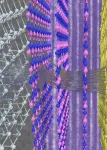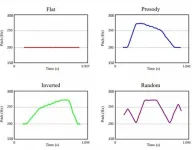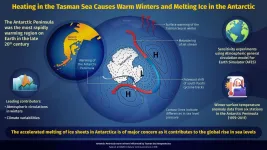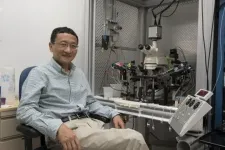Microchips of the future: Suitable insulators are still missing
Until now, hexagonal boron nitride was considered the insulator of choice for miniaturized transistors -- new investigations by TU Wien (Vienna) show: This may not be the way to go
2021-03-09
(Press-News.org) For decades, there has been a trend in microelectronics towards ever smaller and more compact transistors. 2D materials such as graphene are seen as a beacon of hope here: they are the thinnest material layers that can possibly exist, consisting of only one or a few atomic layers. Nevertheless, they can conduct electrical currents - conventional silicon technology, on the other hand, no longer works properly if the layers become too thin.
However, such materials are not used in a vacuum; they have to be combined with suitable insulators - in order to seal them off from unwanted environmental influences, and also in order to control the flow of current via the so-called field effect. Until now, hexagonal boron nitride (hBN) has frequently been used for this purpose as it forms an excellent environment for 2D materials. However, studies conducted by TU Wien, in cooperation with ETH Zurich, the Russian Ioffe Institute and researchers from Saudi Arabia and Japan, now show that, contrary to previous assumptions, thin hBN layers are not suitable as insulators for future miniaturised field-effect transistors, as exorbitant leakage currents occur. So if 2D materials are really to revolutionise the semiconductor industry, one has to start looking for other insulator materials. The study has now been published in the scientific journal "Nature Electronics".
The supposedly perfect insulator material
"At first glance, hexagonal boron nitride fits graphene and two-dimensional materials better than any other insulator," says Theresia Knobloch, first author of the study, who is currently working on her dissertation in Tibor Grasser's team at the Institute of Microelectronics at TU Wien. "Just like the 2D semiconducting materials, hBN consists of individual atomic layers that are only weakly bonded to each other."
As a result, hBN can easily be used to make atomically smooth surfaces that do not interfere with the transport of electrons through 2D materials. "You might therefore think that hBN is the perfect material - both as a substrate on which to place thin-film semiconductors and also as a gate insulator needed to build field-effect transistors," says Tibor Grasser.
Small leakage currents with big effects
A transistor can be compared to a water tap - only instead of a stream of water, electric current is switched on and off. As with a water tap, it is very important for a transistor that nothing leaks out of the valve itself.
This is exactly what the gate insulator is responsible for in the transistor: It isolates the controlling electrode, via which the current flow is switched on and off, from the semiconducting channel itself, through which the current then flows. A modern microprocessor contains about 50 billion transistors - so even a small loss of current at the gates can play an enormous role, because it significantly increases the total energy consumption.
In this study, the research team investigated the leakage currents that flow through thin hBN layers, both experimentally and using theoretical calculations. They found that some of the properties that make hBN such a suitable substrate also significantly increase the leakage currents through hBN. Boron nitride has a small dielectric constant, which means that the material interacts only weakly with electric fields. In consequence, the hBN layers used in miniaturised transistors must only be a few atomic layers thick so that the gate's electric field can sufficiently control the channel. At the same time, however, the leakage currents become too large in this case, as they increase exponentially when reducing the layer thickness.
The search for insulators
"Our results show that hBN is not suitable as a gate insulator for miniaturised transistors based on 2D materials," says Tibor Grasser. "This finding is an important guide for future studies, but it is only the beginning of the search for suitable insulators for the smallest transistors. Currently, no known material system can meet all the requirements, but it is only a matter of time and resources until a suitable material system is found."
"The problem is complex, but this makes it all the more important that many scientists devote themselves to the search for a solution, because our society will need small, fast and, above all, energy-efficient computer chips in the future," Theresia Knobloch is convinced.
INFORMATION:
Contact:
Dipl.-Ing. Theresia Knobloch
Institute for Microelektronics
TU Wien
+43 1 58801 36059
theresia.knobloch@tuwien.ac.at
Prof. Tibor Grasser
Institute for Microelektronics
TU Wien
+43 1 58801 36000
tibor.grasser@tuwien.ac.at
[Attachments] See images for this press release:

ELSE PRESS RELEASES FROM THIS DATE:
2021-03-09
Prosody is a branch of linguistics that analyses and formally represents the elements of oral expression such as pitch, tones and intonation. A study published in Cognition on 5 February shows that there are universal prosodic cues that help with learning in humans and in animals.
This study, published by Juan Manuel Toro, ICREA research professor and Paola Crespo-Bojorque, researchers of the Center for Brain and Cognition (CBC) of the UPF Department of Information and Communication Technologies (DTIC), is part of the research into language evolution that is being conducted thanks to a European Research Council Starting Grant.
Some of the mechanisms we humans use to learn language are based on general principles ...
2021-03-09
Long life is common among bird parents that get help with childcare. This finding comes from researchers at the universities of Lund and Oxford who reviewed data from more than 9,000 studies.
Being a parent can be tough. In general, animals that care for many offspring die young, at least in species where parents are not helped by others. However, in some species things are different and parents recruit 'helpers' to assist with childcare. In such group-living species, parents often produce lots of young and also live an exceptionally long time. This new research ...
2021-03-09
Thrombotic occlusion of blood vessels, which leads to myocardial infarctions, strokes and venous thromboembolisms, is the major cause of death in the western hemisphere. Therefore, it is of critical importance to understand mechanisms preventing thrombus formation. A new study by the research group of Christoph Binder, Principal Investigator at the CeMM Research Center for Molecular Medicine of the Austrian Academy of Sciences and Professor at the Medical University of Vienna, now explains the important role of immunoglobulin-M (IgM) antibodies in preventing thrombosis. The study published in the journal Blood shows that these antibodies recognize microvesicles, which are ...
2021-03-09
Spiders from the genus Phoneutria - also known as banana spiders - are considered aggressive and among the most venomous spiders in the world, with venom that has a neurotoxic action. These large nocturnal spiders usually inhabit environments disturbed by humans and are often found in banana plantations in the Neotropical region.
One of these spiders, P. boliviensis, is a medically important species widely distributed in Central and South America, whose behaviour, habitat, venom composition, toxicity and bites on humans have already been paid considerable attention in previous research work. Nevertheless, after examining a large pool of museum specimens, biologists from The George Washington University (N. Hazzi and G. Hormiga) began to ...
2021-03-09
Tsukuba, Japan - Because human females have two X chromosomes and males have one X and one Y, somatic cells have special mechanisms that keep expression levels of genes on the X chromosome the same between both sexes. This process is called dosage compensation and has been extensively studied in the fruit fly Drosophila. Now, researchers at the University of Tsukuba (UT) continued work with Drosophila to show that dosage compensation does not occur in the germ cells of male flies.
In an article published in Scientific Reports, the UT researchers investigated this phenomenon in fly primordial germ cells (PGCs), which are present in embryos and are the precursor cells to what ultimately become ...
2021-03-09
Pierfranco Demontis said in 1988, "Ice becomes a fast-ion conductor at high pressure and high temperatures," but his prediction was only hypothetical until recently. After 30 years of study, superionic water ice was verified experimentally in 2018. Superionicity may eventually explain the strong magnetic field in giant planetary interiors.
What about Earth, whose interiors are also under extreme pressure and temperature conditions? Although three-quarters of Earth's surface is covered by water, standalone water or ice rarely exists in Earth's interiors. The most common unit of "water" is hydroxyl, which is associated with host minerals to make ...
2021-03-09
The melting of the Earth's ice cover intensified in the 20th century, with glaciers and sea ice in the Arctic and Antarctic regions melting at alarming speeds. In fact, The Antarctic Peninsula (AP), which is the only landmass of Antarctica extending out past the Antarctic Circle, was found to be one of the most rapidly warming regions on the planet during the second half of the 20th century. This rapid change in climate has raised serious concerns of rising sea levels the world over.
Multiple factors have been associated with the melting of the ice cover: the primary factor being the greenhouse gas emissions from human activities that cause ...
2021-03-09
Anxiety levels in the United States are rising sharply and have especially intensified in younger populations. According to the Anxiety and Depression Association of America, anxiety disorders affect 31.9 percent of children ages 13 to 18 years old. Because of the COVID-19 pandemic, children and adolescents have experienced unprecedented interruptions to their daily lives and it is expected that these disruptions may precipitate mental illness, including anxiety, depression, and/or stress related symptoms.
Traditional anxiety and depression treatments include ...
2021-03-09
A critical ingredient for auroras exists much higher in space than previously thought, according to new research in the journal Scientific Reports. The dazzling light displays in the polar night skies require an electric accelerator to propel charged particles down through the atmosphere. Scientists at Nagoya University and colleagues in Japan, Taiwan and the US have found that it exists beyond 30,000 kilometres above the Earth's surface - offering insight not just about Earth, but other planets as well.
The story of aurora formation begins with supersonic plasma propelled from the Sun into space as high-speed, charged particles. When these charged particles get close to Earth, they are ...
2021-03-09
Scientists at the University of Virginia School of Medicine have developed a tool to monitor communications within the brain in a way never before possible, and it has already offered an explanation for why Alzheimer's drugs have limited effectiveness and why patients get much worse after going off of them.
The researchers expect their new method will have tremendous impact on our understanding of depression, sleep disorders, autism, neurological diseases and major psychiatric conditions. It will speed scientific research into the workings of the brain, they say, and facilitate the development of new treatments.
"We can now 'see' how brain cells communicate in sharp detail in both the healthy and diseased brains," said lead researcher J. Julius Zhu, PhD, of UVA's Department ...
LAST 30 PRESS RELEASES:
[Press-News.org] Microchips of the future: Suitable insulators are still missing
Until now, hexagonal boron nitride was considered the insulator of choice for miniaturized transistors -- new investigations by TU Wien (Vienna) show: This may not be the way to go








